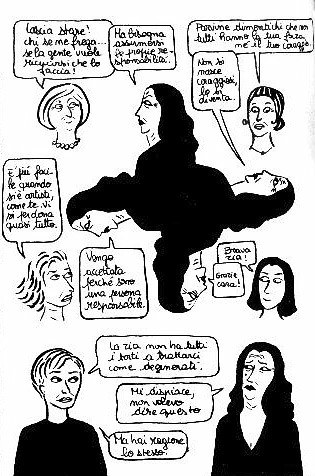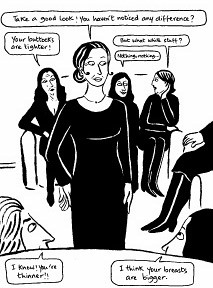George Lucas’ ‘Star Wars – Episode III: Revenge of the Sith’ (2005)
The Star Wars franchise began in 1977 and now, 28 years later, the saga is complete. And, wow, do I have pity for those people who have waited almost thirty years to discover the end, er, beginning of the story.
The film’s offenses:
- The script. The trick to prequels is maintaining dramatic tension despite the audience’s awareness of the events’ effects. Even I, a casual Star Wars observer, knew that Obi-Wan and Yoda would survive the attack on the Jedi, Anakin would become an unattractive, bald asthmatic and strap on his plastic suit, Padmé would produce two offspring, the babies would be split up, etc. Hindered by his ability to write dialogue that only barely resembles human speech, Lucas succeeds in creating that dramatic tension about 30% of the time. Here’s an impressive example of Lucas’ writing craft—and by “impressive” I mean “produces that vomit taste at the back of your mouth”:
Anakin: You’re so beautiful.
Padmé: That’s because I’m so in love.
Anakin: No, it’s because I’m in love with you.
Padmé: Are you saying that you’re blinded by love?
Anakin: That isn’t quite what I meant.
And here, I believe, lies the series’ greatest problem: the relationship between Anakin and Padmé. Lucas wants the audience to see Anakin/Darth Vader as a tragic figure because he embraces the Dark Side to save his wife. The first two movies should have, and indeed tried, to develop the relationship between the two so that the audience would understand Anakin’s feeling as though he had no other choice than to embrace the Dark Side to save Padmé. But see the above dialogue for an example of Lucas’ skill at writing love scenes. And he made the grave mistake of casting Hayden Christensen against Natalie Portman with whom Christensen has absolutely no screen chemistry. The actors try, especially in this film, and they even succeed in creating some sexual tension for the span of about five seconds, but even their great efforts cannot invest the relationship with romance and significance. Besides dialogue, Lucas’ other great script offense lies in the number of scenes he feels the story needs. Going back to dramatic tension, tension is built through sustained contact between characters and the audience. Having five lines of dialogue and then an annoying scene wipe to a few hours later does not build tension so much as destroy it. Perhaps Lucas intends the jumps to increase the film’s momentum, but they tend to have the opposite effect for me because the wait to discover pertinent information feels artificially imposed rather than an organic part of the storytelling. - The acting. Lucas is not an actor’s director. I know that Natalie Portman can act—her recent performance in Closer is wonderful—but the three Star Wars films in which she participated have no evidence of her great acting ability. Even her brief appearance in Cold Mountain showcases more of her ability than her three Star Wars performances combined. Hayden Christensen has also displayed real acting talent in two of his films, Shattered Glass and Life as a House, but his performance in Episode II portrayed Anakin as a one-dimensional, petulant teenager. His acting is markedly improved in this prequel but does not reach the complexity he displayed as Sam, for example, in Life as a House, a young man not unlike Anakin. Ian McDiarmid offers the most offensive performance of the film as Chancellor Palpatine/Darth Sidious. The film’s limited sets must have his teeth marks on every prop. Granted, McDiarmid manages to be genuinely creepy at times but his melodramatic performance ruins many of the dramatic moments of the film.
- Anakin’s turn to the Dark Side. That was it? That was it? Man, that sucked. I can think of at least five other ways to play out that moment that would have been more realistic and more dramatic. In Lucas’ version, Anakin is lecturing Mace Windu about the “Jedi way” two minutes before he says, “Sure, wrinkly master, sir, I’ll be a sith. Do I get a nifty cape too?”
And speaking of a cape, way to telegraph Anakin’s turning by dressing him in black, giving him a scar and bad hair. All he needed was a British accent, which he inexplicably slipped into every now and then anyway. (Lucas couldn’t have used another take or looped those lines?)
The film’s assets:
- The visual effects. As usual, Lucas presents a visually impressive film. Though I hesitate at whether to put the visual effects as an asset or an offense. I suppose the effects are truly an asset because people will want to watch this film again to experience the detail of the visual landscape. However, I think that Lucas’ obsession with visuals hinders him as a filmmaker. He becomes so concerned with effects that everything else becomes secondary: the story, the characters, the pacing, etc. To repeat one of my critiques, Lucas has many more scenes than necessary, probably to service his desire to impress the audience with visionary effects. And this film suffers the same fate as The Matrix Reloaded: some of the effects do not look real enough so that the viewer feels as though she is watching a video game instead of a film. At this point, Lucas should have lost the live action actors and made Episode III a digital animation film. The original trilogy’s effects were not nearly as sophisticated, but the films felt more real because the sets were real and not a green screen and the robots and monsters were practical rather than digitally inserted. Even though Lucas’ saga is supposed to take place in another world, I want to feel as though it could occur in a real world and not a land of digital animation.
- The intercuts. Lucas manages some effective intercutting between the fight with Yoda and Darth Sidious and the fight with Obi-Wan and Anakin and between Anakin’s death/rebirth as Darth Vader and Padmé’s death and the birth of Luke and Leia.
I can honestly call this film the best of the prequels, but that statement does not mean much. Episode III is entertaining enough and, of course, visually impressive, but Lucas has finished his epic series with a decent film rather than a great one.


 This blog contains what I think about movies, TV, short stories and crap like that. This blog is chock-full o' spoilers, so be warned. Though I don't tend to write about anything current, so I doubt there's much here to spoil anybody.
This blog contains what I think about movies, TV, short stories and crap like that. This blog is chock-full o' spoilers, so be warned. Though I don't tend to write about anything current, so I doubt there's much here to spoil anybody.